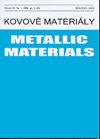Diffusion brazing of Nicrofer 5520 (IN-617) superalloy using an amorphous Ni-Cr-Si-B interlayer: Microstructural characterization and mechanical properties
IF 0.7
4区 材料科学
Q4 MATERIALS SCIENCE, MULTIDISCIPLINARY
引用次数: 1
Abstract
The applicability of the diffusion brazing technique for bonding Nicrofer 5520 superalloy was assessed. The experiments were carried out at 1120◦C for 5, 15, 20, 45, 90, 120, and 240 min holding times using 30 μm thick Ni-7%Cr4.5%Si-3.1%B interlayers. The microstructure, shear strength, and microhardness of the resultant joints were investigated. The results showed that the complete isothermal solidification (CIS) occurred after 20 min-holding time. The (Mo, Cr, Ni, Fe)-rich carbides and (Cr, Mo)-rich borides with various morphologies were observed in the diffusion-affected zone (DAZ). Before CIS, a Ni-rich boride and Ni-rich silicide along with Cr and Mo-rich borides were also detected in the centerline. After CIS, the volume fraction of precipitated phases in the DAZ region was reduced by increasing the holding time. Simultaneously, the chemical composition became more uniform; also, the shear strength of the specimens was improved, and for the 240 min-holding time, it reached about 93 % of that of the base metal. K e y w o r d s: Nicrofer 5520, diffusion brazing, bonding time, microstructure, mechanical properties非晶Ni-Cr-Si-B间层扩散钎焊Nicrofer 5520 (IN-617)高温合金的显微组织表征和力学性能
评价了扩散钎焊技术在Nicrofer 5520高温合金焊接中的适用性。实验采用30 μm厚Ni-7%Cr4.5%Si-3.1%B夹层,在1120℃下保温5、15、20、45、90、120和240 min。研究了接头的显微组织、抗剪强度和显微硬度。结果表明:保温时间为20 min后,合金发生完全等温凝固。在扩散影响区(DAZ)观察到不同形态的富(Mo, Cr, Ni, Fe)碳化物和富(Cr, Mo)硼化物。在CIS之前,在中心线上还检测到富ni硼化物和富ni硅化物以及富Cr和富mo硼化物。CIS处理后,随着保温时间的延长,DAZ区析出相的体积分数有所降低。同时,化学成分变得更加均匀;同时,试样的抗剪强度也有所提高,保温时间为240 min时,抗剪强度达到母材的93%左右。微晶合金5520,扩散钎焊,结合时间,显微组织,力学性能
本文章由计算机程序翻译,如有差异,请以英文原文为准。
求助全文
约1分钟内获得全文
求助全文
来源期刊

Kovove Materialy-Metallic Materials
MATERIALS SCIENCE, MULTIDISCIPLINARY-METALLURGY & METALLURGICAL ENGINEERING
CiteScore
1.20
自引率
14.30%
发文量
36
审稿时长
3 months
期刊介绍:
Kovove Materialy - Metallic Materials is dedicated to publishing original theoretical and experimental papers concerned with structural, nanostructured, and functional metallic and selected non-metallic materials. Emphasis is placed on those aspects of the science of materials that address:
the relationship between the microstructure of materials and their properties, including mechanical, electrical, magnetic and chemical properties;
the relationship between the microstructure of materials and the thermodynamics, kinetics and mechanisms of processes;
the synthesis and processing of materials, with emphasis on microstructural mechanisms and control;
advances in the characterization of the microstructure and properties of materials with experiments and models which help in understanding the properties of materials.
 求助内容:
求助内容: 应助结果提醒方式:
应助结果提醒方式:


